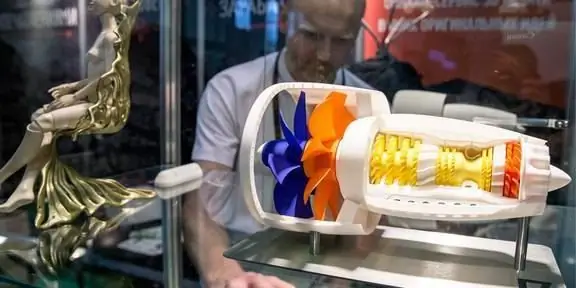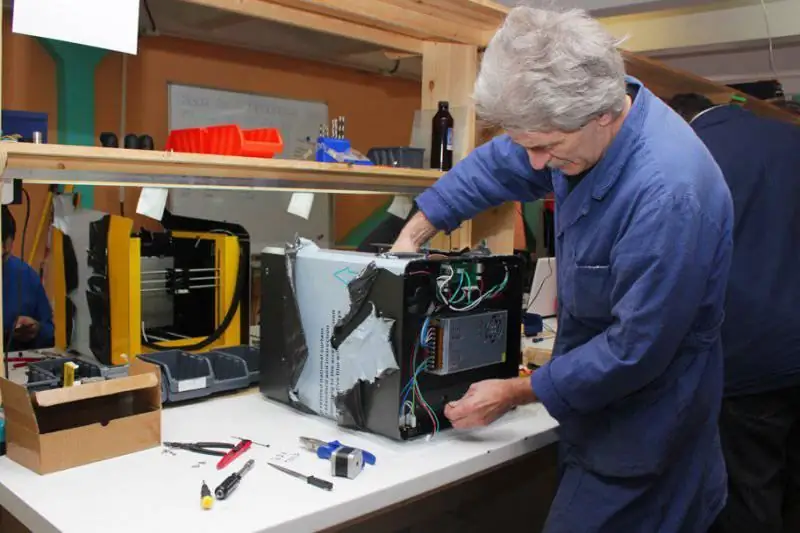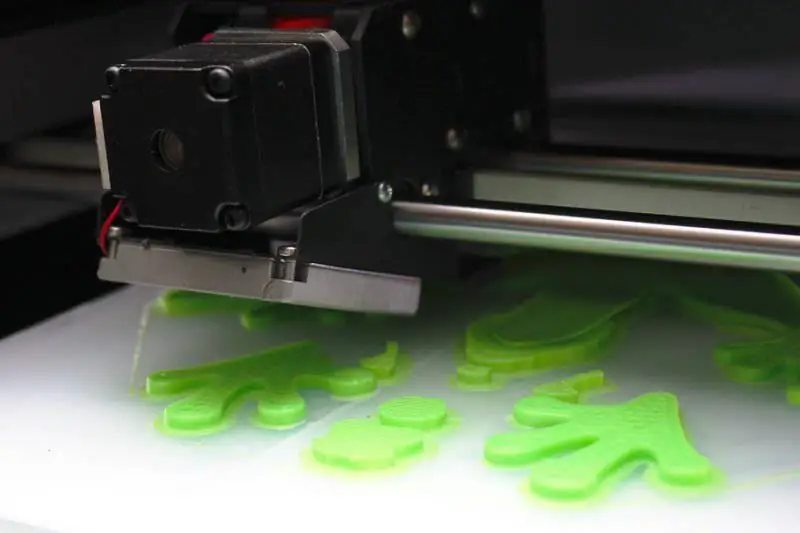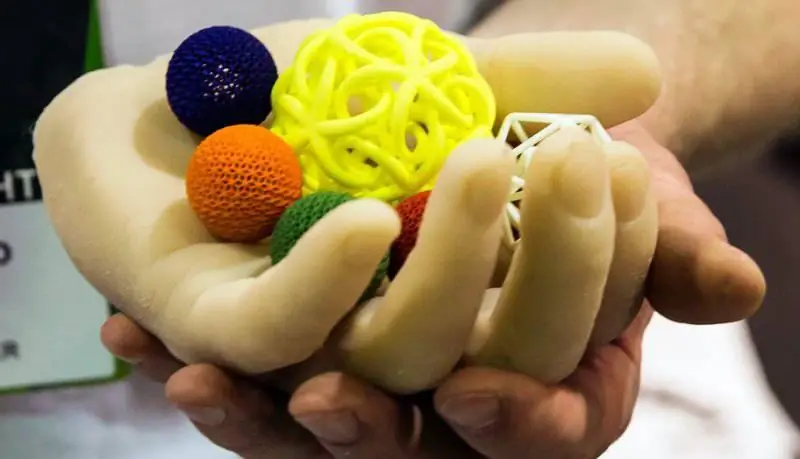- Author Matthew Elmers [email protected].
- Public 2023-12-16 21:49.
- Last modified 2025-01-24 09:17.

The newborn Russian 3D industry can become competitive and large-scale if ordinary consumers see the advantage and cheapness of the new production method, and large companies will use them more widely. In the meantime, the market is growing at the expense of mobile small and medium-sized private companies and educational institutions.
Watching the birth of a new type of production, especially an innovative one, is extremely entertaining. Desktop 3D printers have been developing in Russia for three years, and the first sales began at the end of 2011. During this time, six companies have already put forward their products on the market! On the one hand, everyone considers this market to be fast growing and very promising. On the other hand, big business shows no interest in a new market niche. However, the production of 3D printers has already become the lot of not only small, but also medium-sized enterprises. But will Russian 3D printer production be able to survive? One of the threatening trends is the growing competition with Western manufacturers: in the spring of this year, some market participants started talking about the beginning of a price war. Another factor of slipping is the conservatism of potential buyers, which could be numerous scientific institutes, design bureaus and defense industry enterprises. But there is also a positive trend: this year 3D printers began to actively purchase the education system - additional and professional. In addition, this year wealthy Russians saw the "miracle printing" and began to buy 3D printers for home use. So far, it's just fun - to "print" any toy, cup, spoon or even shoes yourself. But soon many will realize that a 3D printer at home is as necessary as a computer. And domestic companies have the opportunity to participate in the emerging 3D boom.
Explosive growth of 3D printing
The history of 3D printing dates back to 1948, when the American Charles Hull developed a technology for the layer-by-layer growth of physical three-dimensional objects from a photopolymerizable composition (FPC). The technology is called stereolithography (STL). However, Hull received a patent for his invention only in 1986. At the same time, he founded the company 3D System and began developing the first industrial device for three-dimensional printing, a prototype of which was presented a year later. It was he who helped Hull become a multi-billionaire. His device grew a computer-modeled three-dimensional object from a liquid photopolymerizable composition, applying it layer by layer onto a movable platform.
In the late nineties, other 3D printing technologies appeared - selective laser sintering (SLS), which allows you to produce objects from metal, ceramic, gypsum powder. Then came the filament layering method (FDM). The essence of this technology is that in the print head the material (melt made of plastic, metal, foundry wax) is preheated to the melting temperature and enters the working chamber in a sprayed form.
In 2005, the RepRap project appeared in the USA - a self-copying device that can be used for rapid prototyping and production. The RepRap device is a 3D printer capable of creating volumetric artifacts from computer-generated models. One of the goals of the project is "self-copying", defined by the authors as the device's ability to reproduce the components necessary to create another version of itself.
After 2008, when Hull's patent expired, the open-source STL technology and others like it allowed, along with RepRap technology, to earn thousands of companies around the world. Printers baked like cakes. The companies added their own modification of any of the components to the existing printers and branded them. This is how the 3D boom began: the market grew by 50%, and in some places by 150% per year.
In recent years, companies have moved from the production of large and expensive printers for industrial enterprises (cost from one hundred thousand dollars) to a new segment - the production of small cheap "desktop" printers that are suitable for use even in everyday life. As a rule, most "desktop" 3D printers work on the technology of layering the molten polymer filament.
Pioneers
It is significant that in Russia the first domestic 3D printer did not appear at all from the monsters of the industry. It was made by enthusiastic students from Zelenograd. It all started with a robot. Fourth-year students of the Moscow Institute of Electronic Technology (MIET) Andrei Isupov and Maxim Anisimov defended their thesis, creating a six-fingered multifunctional robot.

“It all started in 2010, I was preparing a project for a six-fingered robot. There was a need to create your own body for him. Then, on the Internet, I came across the Opensource 3D printer RepRap project and, delving deeper into this issue, I realized that this is exactly what I need, - Andrey Isupov told Expert Online. - The printer itself was inexpensive, and printing models cost a few rubles per cubic centimeter of material. The print quality did not suit me and I decided to upgrade the printer. So, step by step, the first Russian 3D printer began to appear”.
This is a classic example of a start-up. We started ourselves, as the founders of Apple and Microsoft once did - in the garage, more precisely in a one-room apartment. The first grant was received from the Bortinka Foundation at the U. M. N. I. K. competition - 200 thousand rubles. Here they were noticed by the Zelenograd Nanotechnology Center (ZNTC), which was the first to invest in the project. Before the investment, there were also their own investments, about half a million rubles.
In total, over three years the company has attracted from various venture capitalists up to 6 million rubles. The brainchild was named PICASO 3D - now it is already a well-known trademark.

“Now we continue to develop the technology, applications have been submitted for patenting our own technical, engineering and software solutions, thanks to which our printer surpasses many Western counterparts in accuracy, quality and print speed,” explained Maxim Anisimov.
The company is located in three premises in one of the historic buildings next to MIET. One room for an office and two production premises with a total area of more than 200 meters. Here printers are actually assembled and tested. In total, PICASO 3 D employs about 30 people.
PICASO 3D prints by overlaying molten plastic layers - the most requested technology on the market. In total, five types of plastic are used, which differ in their properties. Today the printer costs 99 thousand rubles, which is considered the optimal price for printing of this quality (most Western counterparts cost an average of 150 thousand rubles). PICASO 3D printers began to sell at the beginning of last year. The company gained new growth when a new co-founder Nikolay Bobrov, a former top manager of Renault-Avtovaz, joined the creators of PICASO 3D.
“I was fascinated by the very topic of 3 D-printing, I was engaged in 3D printing services using professional 3D equipment of subcontractors,” recalls Nikolay Bobrov. - Then I realized that in Russia there is already a demand for small printers from design, architectural bureaus and others. I started looking for these abroad, but found them here in Zelenograd. And he was surprised: there is demand, there is a printer, but there is no sales. When I joined the company, I began to establish work processes and create a strategy for long-term growth."
The first PICASO 3D Builder model sold 250 pieces. It is now discontinued and only sold by PICASO 3D Designer. The main buyers are architectural, design companies, fashion designers, furniture makers, design bureaus, inventors.
“The most interesting thing is that we ourselves do not yet fully know all the possible areas of application of 3D printers,” says Nikolai Bobrov. - Sometimes we are surprised at what our customers are doing with these printers. It used to be the same with computers. They have existed for a long time, but they did not enter into mass use for a long time, since people did not know why they were needed at all. And only the creation of computer games became the first motive for purchasing a home computer. The same is with us - now buyers have begun to appear who purchase printers for the home. Basically - for entertainment, they buy it as a gift."
Survival chance
In a short time of its existence, the Russian market for the production of 3D printers was able to become competitive. But few have been "lucky" here so far. The second manufacturer was a company from Nizhny Tagil, which opened the Reprap-Russia website1. They created a modification of the "Chameleon" 3D printer, which cost only 37,500 rubles - more than half the price of the "pioneer" PICASO 3D. But it looks like the business is not going well. Why, one can only guess, there is no connection with the manufacturers of "Chameleon".
The third manufacturer is Pavel Pirogov, founder of the Maket-City company from Kursk. His printer is made on an aluminum base and costs only 44 thousand rubles. But for some reason, the creator of this printer does not see prospects for expanding production:
“My sales of 3D printers are not going,” Pavel Pirogov explained to Expert Online. - But I did not set such a task - their mass production. At first I was interested in the idea, but then I realized that large-scale production for a small business is unrealistic. Although the market is promising, large companies that already have a technological base and employees will take over mass production. They just haven’t discovered this market for themselves”.
The fourth creator of his own 3D printer is still struggling to survive. This is the Print & Play company from Novosibirsk, whose printer costs 35 thousand rubles.
“Now 3D printers are overvalued, since this is a relatively new phenomenon and many have decided to skim the cream,” Andrey Nuzhdov, the founder of Print & Play, explained to Expert Online. - A realistic price - 35 thousand, like ours. PICASO 3D actually has the most accurate printer, we took their first prototype - Gen X (finished production in 2012) as a basis, and made our SibRap-K printer. According to reviews, the quality is slightly worse than that of PICASO 3D. And the price is almost three times lower, since we did not take loans, did not spend on advertising, did not lay down a large rate of return, in our country it is 15-20%. But sales are weak, 2-3 printers per month. This is because we cannot start serial production yet. But now we are negotiating with a large enterprise in order to organize mass production at their production base."

3D printed items
At the end of last year, PICASO 3D had its first strong competitor. The Moscow-based RGT company (develops and manufactures numerical control equipment) released at the end of October last year a PrintBox3D One model, which costs exactly the same as PICASO 3D 3D Designer - 99,000 rubles.
“Consumer goods will become cheaper due to lower print quality, but professional use still needs a machine, not a toy,” Andrey Borisov, RGT Development Director, explained to Expert Online. - Many get burned by buying cheap Chinese models. In fact, they buy a set of parts that they still need to be able to assemble, and then still configure or repair, understand the software. In this sense, domestic manufacturers have great advantages. Well, we did not begin to produce cheaper, because we do not make a toy, but a machine that requires complex systems and parts. However, we will soon launch on the market a more compact and cheaper modification costing 50-60 thousand rubles, it will not be inferior in quality to PrintBox3D One”.
RGT has its own production base. Here is a full production cycle: they themselves make parts, boards, write software. From the acquired - perhaps the wires. That is why RGT has every chance of becoming a large-scale manufacturer of 3D printers in Russia.
“More or less large orders of ten printers are now being made mainly by design bureaus,” says Andrei Borisov. - Now the educational segment is showing activity, but this is either preschool education or resource centers. I think that in Russia the industry is slowing down partly due to the lack of specialists in 3D technologies, partly due to the conservatism of large companies and government agencies. Few people still understand that 3D printing is a way to significantly reduce the costs and time for the production of many types of parts in small-scale production, and especially models. It is impractical to make molds and conveyors for several hundred parts, but they do it, which is reflected in the high cost of production."
A striking example of how state support can contribute to the development of new production is the emergence of youth technical centers in Moscow. The Department of Science, Industrial Policy and Entrepreneurship of the city of Moscow has allocated funds through a competition to private companies to open children's educational resource centers. In particular, thanks to the competition of the Moscow government this month, a new player appeared on the Russian market for the production of 3D printers - the STANKIN-AT company, a private enterprise at the STANKIN MSTU. More precisely, this month they sold their first three Prusa Mendel 3D printers for only 39 thousand rubles.
“We have been developing the printer for a long time, but there were great difficulties with the organization of production, - explained to“Expert Online”Stanislav Konov, associate professor of“STANKIN”, general director of LLC“STANKIN-AT”. - With the funds allocated by the Moscow government, we organized the Center for Youth Innovative Creativity (YICC), equipped with everything that is necessary for the production of a 3D printer. That is why they are the cheapest of all Russian ones. We also save on the payroll fund. Students-enthusiasts are engaged in software, assembly, configuration and other things. And the remuneration is received upon the sale of the printer, while in other companies, only at the development stage, large labor costs are required."
In the technology "STANKIN-AT" they followed the same path as the others: they did not begin to create all the mechanisms from scratch, but copied them, gradually replacing them with their own developments, which are again made by students. Each new sample is ultimately different from the previous one.
STANKIN-AT and TsMIT are now working on a new multifunctional device that will combine a 3D printer, a milling machine and a contact scanner for modeling parts. So far, no one has succeeded.
“Our equipment allows us to set up small-scale production, but there are no orders yet, although we have a clear competitive advantage in terms of price,” says Stanislav Konov. - Frankly, there is no time to engage in marketing. But we will participate in various exhibitions, this will help promote our products."
Abroad destroys prices
Will the Russian market for the production of 3D printers be able to compete with Western manufacturers, who had time to establish large-scale production and save on costs? It seems that all the prerequisites for this exist. Despite the fact that some foreign manufacturers of 3D printers in the spring began to reduce prices (from an average one hundred thousand rubles to 50-70), ours have other clear advantages.
“Our company was the first to bring 3D printers to Russia,” said Yulia Sokolova, customer service manager of 3D printers seller 3D Razvitie LLC, to Expert Online. “This is the UP! Model, developed by a US company and assembled by China. It was chosen because of its simple software. Many clients find it difficult to understand software for 3D printers, so they relied on simple solutions. But domestic manufacturers are now taking revenge. People choose them because these are Russian companies, which means that the service is available, there will be no problems with setting up, with details. And the software is in Russian, which is important to many."
For example, the start-up company Hyperbok, the manufacturer of Hyperkolobok, a Russian domestic robot, has relied on the domestic PICASO 3D printer. "Hyperkolobok" is an electronic toy that can perform not only programmed actions - this robot can be safely called the world's first robot-friend, thanks to its ability to think. The robot has its own character and the ability to evolve. Every day he learns from the events taking place around him, and remembers what his owner likes and what not. May even check the child's homework.
“I chose PICASO 3D, because the accuracy of printing is very important to me - in order to rework the details less, as they say, with a file,” Lyubov Orlova, Development Director of Hyperbok, explained to Expert-Online. - In our kolobok there are 45 complex parts, which must all interact with each other, and for this a very high accuracy is required. We do not use 3D printing services, since logistics is also important to us. You will order there, while you wait in line, until they are delivered. And so we can remake the same engine in one day by printing the parts themselves."
The creators of Alice, the first robot-android in Russia, also preferred the Russian printer to the PICASO 3D company. It prints piece parts for Alice, which would be too expensive to cast on molds.
“The market is growing mainly due to the fact that regional companies have begun to discover 3D technology for themselves,” says Yulia Sokolova. - Until recently, the main sales were in Moscow and St. Petersburg. Lately, a lot of inquiries have come from educational institutions. But the problem is that the Ministry of Education has not developed a methodology for working and teaching in 3D, so this principle cannot be used in the educational standard. But additional school education does not require clear standards, these are circles, and printers are bought for them. Universities, especially architectural and design ones, also actively began to take 3D printers. Another trend is that at the end of last year they began to buy more printers for home use and entertainment. Some people just buy printers as a gift."
By the way, PICASO 3D is also expanding its business at the expense of resource centers for children's creativity: now negotiations are underway on the supply of 3D printers, on which children will master the new printing technology.
Another possible vector for the development of the production of 3D printers is large companies. But here the problem lies in stereotypes and banal ignorance of the advantages of the new technology.
For example, so far, of the major customers, only the S-7 airline has contacted the Moscow RGT. They needed 3D printing to make dozens of aircraft parts. We decided that it’s cheaper to buy our own printer than to place orders for manufacturing.
“Can you imagine what needs for low-volume, cheap production at defense enterprises! - says Andrey Borisov. - But there everyone works in the old fashioned way and does not think about the price, because there is a state order. If large companies turned to 3D, we could meet the demand and enter the large-scale production of printers. It is even more difficult with government agencies - this colossus is generally difficult to stir up, although in the same education there could be a great demand for 3D printing”.
Now in Russia a course has been announced for a widespread cost reduction. 3D printing is a great option for dramatically reducing costs in small batch production. So now is the time for the state to pay attention to the emerging industry and at least start talking about the need to support this innovative business.






